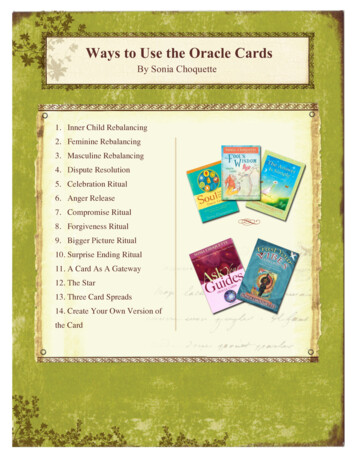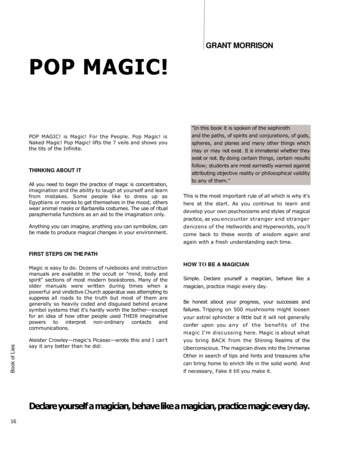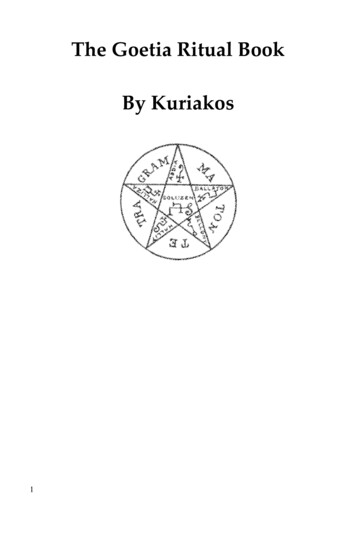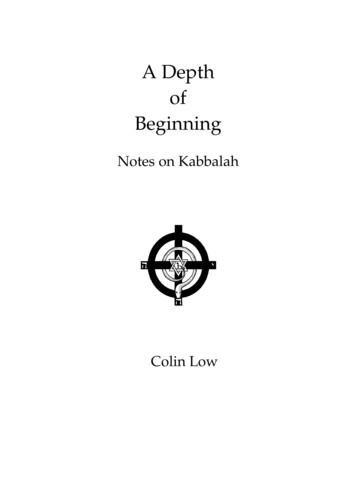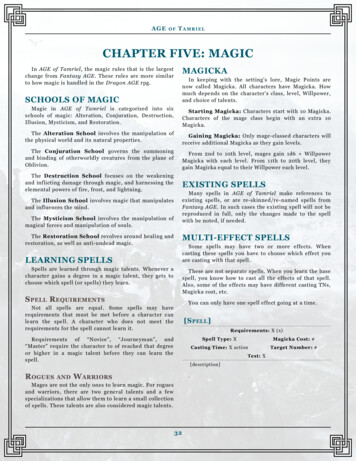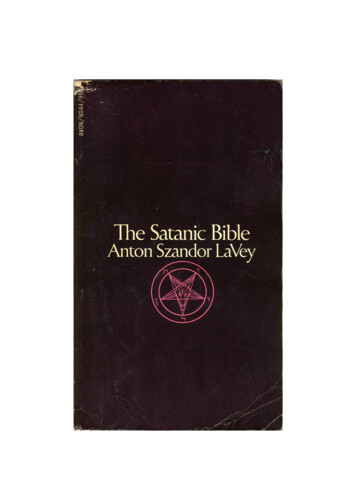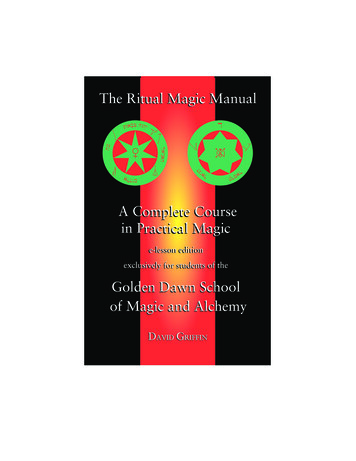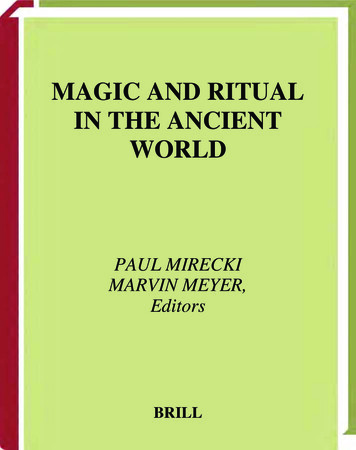
Transcription
MAGIC AND RITUALIN THE ANCIENTWORLDPAUL MIRECKIMARVIN MEYER,EditorsBRILL
RGRW.Mirecki/Meyer.141.vwc19-11-200114:34Pagina IMAGIC AND RITUAL IN THE ANCIENT WORLD
RGRW.Mirecki/Meyer.141.vwc19-11-200114:34Pagina IIRELIGIONS INTHE GRAECO-ROMAN WORLDEDITORSR. VAN DEN BROEK H. J. W. DRIJVERSH. S. VERSNELVOLUME 141
RGRW.Mirecki/Meyer.141.vwc19-11-200114:34Pagina IIIMAGIC AND RITUALIN THE ANCIENT WORLDEDITED BYPAUL MIRECKIANDMARVIN MEYERBRILLLEIDEN BOSTON KÖLN2002
RGRWMIRE.VWC6/2/20049:18 AMPage ivThis series Religions in the Graeco-Roman World presents a forum for studies in the social and culturalfunction of religions in the Greek and the Roman world, dealing with pagan religions both in their ownright and in their interaction with and influence on Christianity and Judaism during alengthy period of fundamental change. Special attention will be given to the religious history of regions andcities which illustrate the practical workings of these processes.Enquiries regarding the submission of works for publication in the series may be directed to ProfessorH.J.W. Drijvers, Faculty of Letters, University of Groningen, 9712 EK Groningen, The Netherlands.This book is printed on acid-free paper.Die Deutsche Bibliothek – CIP-EinheitsaufnahmeMagic and ritual in the ancient world / ed. by Paul Mirecki and MarvinMeyer. – Leiden ; Boston ; Köln : Brill, 2001(Religions in the Graeco-Roman world ; Vol. 141)ISBN 90–04–10406–2Library of Congress Cataloging-in-Publication DataLibrary of Congress Cataloging-in Publication Data is also availableISSN 0927-7633ISBN 90 04 11676 1 Copyright 2002 by Koninklijke Brill nv, Leiden, The NetherlandsAll rights reserved. No part of this publication may be reproduced, translated, stored ina retrieval system, or transmitted in any form or by any means, electronic,mechanical, photocopying, recording or otherwise, without prior writtenpermission from the publisher.Authorization to photocopy items for internal or personaluse is granted by Brill provided thatthe appropriate fees are paid directly to The CopyrightClearance Center, 222 Rosewood Drive, Suite 910Danvers MA 01923, USA.Fees are subject to change.printed in the netherlands
CONTENTSP M and M M Introduction . : W B † and Roy KotanskyA New Magical Formulary .3D J Two Papyri with Formulae for Divination . 25R K An Early Christian Gold Lamella for Headache . 37P M A Seventh-Century Coptic Limestone in the AshmoleanMuseum, Oxford (Bodl. copt. inscr. 426) . 47 : J Z. S Great Scott! Thought and Action One More Time . 73F G Theories of Magic in Antiquity . 92H. S. V The Poetics of the Magical Charm: An Essay on the Powerof Words . 105D F Dynamics of Ritual Expertise in Antiquity and Beyond:Towards a New Taxonomy of “Magicians” . 159C. A. H Fiat Magia . 179MM 01 Voorwerk v3516-11-2001, 12:09
: R H. B Dividing a God . 197J A S Translating Transfers in Ancient Mesopotamia . 209B J C Necromancy, Fertility and the Dark Earth: The Use ofRitual Pits in Hittite Cult . 224B B. S Canaanite Magic vs. Israelite Religion: Deuteronomy 18and the Taxonomy of Taboo . 243 : S. D B Secrecy and Magic, Publicity and Torah: Unpacking aTalmudic Tale . 263J R. D Shamanic Initiatory Death and Resurrection in the HekhalotLiterature . 283Michael D. SwartzSacrificial Themes in Jewish Magic . 303 : C A. F The Ethnic Origins of a Roman-Era Philtrokatadesmos(PGM IV 296-434) . 319S I J Sacrifice in the Greek Magical Papyri. 344L R. L D Beans, Fleawort, and the Blood of a Hamadryas Baboon:Recipe Ingredients in Greco-Roman Magical Materials . 359MM 01 Voorwerk v3616-11-2001, 12:09
O P The Witches’ Thessaly . 378P T. S Speech Acts and the Stakes of Hellenism in Late Antiquity . 386 : M M The Prayer of Mary Who Dissolves Chains in Coptic Magicand Religion . 407A T The Magician and the Heretic: The Case of Simon Magus. 416N B. H Ancient Execration Magic in Coptic and Islamic Egypt . 427Index of Primary Sources . 447MM 01 Voorwerk v3716-11-2001, 12:09
In memory ofWilliam M. Brashear1946 – 2000MM 01 Voorwerk v3816-11-2001, 12:09
INTRODUCTIONP M and M M If the title of the present volume, Magic and Ritual in the Ancient World,is reminiscent of an earlier volume in the Brill series Religions in theGraeco-Roman World, it should come as no surprise. In August 1992Paul Mirecki and Marvin Meyer invited a series of colleagues from avariety of disciplines to an international conference, held at the University of Kansas in Lawrence, Kansas, on “Magic in the AncientWorld.” The scholars in attendance all addressed the phenomena ofancient magic and ritual power from the perspectives of their owndisciplines, but they did so with a particular concern for the generalissues of definition and taxonomy. From that conference thereemerged a volume, edited by Meyer and Mirecki and published in1995 by Brill, entitled Ancient Magic and Ritual Power. As noted in theintroduction to the volume, “An understanding of ‘magic’ as ‘ritualpower’ permeates many of the essays in this volume” (4).The present volume comes from a similar scholarly conference. InAugust 1998 Meyer and Mirecki assembled the magoi once again—many of them the usual suspects—at a second international conference, held at Chapman University in Orange, California, and theInstitute for Antiquity and Christianity of Claremont Graduate University in Claremont, California, on “Magic in the Ancient World.”(This conference was made possible through the generous support ofthe Griset Lectureship Fund and the Wang-Fradkin Professorship ofChapman University and the Coptic Magical Texts Project of theInstitute for Antiquity and Christianity.) As at the Kansas conference,Jonathan Z. Smith delivered a plenary lecture, and the scholars at theCalifornia conference similarly employed the methods and perspectives of their disciplines to discuss ancient magic and ritual power.And as at the Kansas conference, the volume emerging from theconference, Magic and Ritual in the Ancient World, seeks to contribute tothe continuing discussion of magic and ritual power in the ancientNear East, Judaism, Greco-Roman antiquity, and early Christianity,with an additional contribution on the world of Coptic and IslamicEgypt.The strength of the present volume, we suggest, lies in the breadthof scholarship represented. While, as in the previous volume, issues ofdescription and classification are everywhere apparent or assumed inthese essays (and especially in Part 2), and the understanding of magicMM 01 Voorwerk v3916-11-2001, 12:09
as ritual power runs as a scholarly thread through the book, the essaysthemselves are remarkably wide-ranging in their approaches and concerns. Taken together, the essays thus provide an excellent glimpse ofthe status quaestionis of the study of magic and ritual power in Mediterranean and Near Eastern antiquity and late antiquity.* * *The essays in this volume are organized into six sections: 1) “NewTexts of Magic and Ritual Power,” 2) “Definitions and Theory,” 3)“The Ancient Near East,” 4) “Judaism,” 5) “Greek and Roman Antiquity,” and 6) “Early Christianity and Islam.”Part 1 presents four essays in which new magical texts and newinterpretations are made available. In an essay entitled “A NewMagical Formulary,” William Brashear and Roy Kotansky presentthe editio princeps of P. Berol. 17202. This fourth-century papyrus sheetfrom a magical handbook preserves six recipes in Greek: a Christianliturgical exorcism with historiolae focusing on Jesus’ miracles, a paganinvocation to silence opponents, a hymnic invocation, an adjurationwith ritual procedures, a spell to achieve an erection, and a sacredstele termed the “second.” In “Two Papyri with Formulae for Divination,” David Jordan improves upon two previously published papyriwith formulae for divination (PGM XXIVa and LXXVII). The firstinvolves a ritual with 29 palm leaves, each with the name of a godwritten upon it, and the other involves instructions for receiving anoracle through an invocation. In “An Early Christian Gold Lamellafor Headache,” Roy Kotansky presents the editio princeps of a Greektext from a private collection in London. This second-century lamellamay derive from a Hellenistic Jewish milieu that appropriated Jesus’name for its magical purposes, or from an early type of Jewish-Christianity. The text apparently dates from a time when magical texts hadnot yet been “commercialized” to the extent that can be observedwhen later formulaic language replaced the more independent styleof amulet composition. In “A Seventh-Century Coptic Limestone inthe Ashmolean Museum, Oxford (Bodl. Coptic inscr. 426),” PaulMirecki presents the editio princeps of a series of short texts written ona large Coptic limestone. The titles and incipits of the four gospelsand a list of the apostles’ names often occur together in Christianmagical texts, suggesting a context of ritual power for these texts andeven for the limestone itself. The wide-ranging possibilities for thestone’s function suggest either that it was a scribe’s display copy forschool texts or for the writing of amulets, or else that it was a monastic boundary stone with inspirational or apotropaic words of power.MM 01 Voorwerk v31016-11-2001, 12:09
Part 2 presents five essays that address explicitly theoretical matters of definition and description. In “Great Scott! Thought and Action One More Time,” Jonathan Z. Smith opens his essay with adiscussion of the origin and meaning of the popular thaumatic ejaculation “Great Scott!,” which serves as an entree into the scholarlydebate on the definition of magic as a phenomenon that is eitherprimarily “thought (belief)” or “action (ritual).” Smith concludes witha plea for a theoretical resolution to this question of duality. In“Theories of Magic in Antiquity,” Fritz Graf responds to R. A.Markus’ study on pre-Augustinian theories about magic and Augustine’s own neglected semiotic theory. Graf demonstrates that therewere several different pre-Augustinian theories of magic in bothGreek and Roman thinking, and that Augustine’s theory was not asneglected as Markus supposes. Graf offers suggestions on how theresults of his study are useful for the further history of theoreticalreflections on magic. In “The Poetics of the Magical Charm: AnEssay on the Power of Words,” Henk Versnel addresses poetics in thedouble sense of “the art of making poetry and the art of creation.”Through a careful exegesis of several texts, Versnel demonstrates thatthe magical charm is the product of a happy alliance between theexpectancy of a marvelous potential in an “other world,” beyond theboundaries of space and time, and oral utterance, which can belongto common communication or can even transcend speech and helpcreate the “other world.” In “Dynamics of Ritual Expertise in Antiquity and Beyond: Towards a New Taxonomy of ‘Magicians,’” DavidFrankfurter offers a cross-cultural analysis of what he calls “the dynamics of ritual expertise,” in the service of constructing a spatial(center/periphery) model for understanding indigenous conceptionsof ritual expertise. This model, which allows for a certain fluidityamong types, engages current discussions of taxonomy in the historyof religions (definitions of “magic” and “magicians”) beyond the staticclassifications of M. Weber and G. Van der Leeuw. In “Fiat Magia,”Christopher A. Hoffman begins with E. E. Evans-Pritchard’s observation that all labels (such as the term “magic”) are essentially arbitrary,and proceeds to survey some of the major approaches andtaxonomies in the modern history of the study of magic. Hoffmanends by noting that the approaches he surveys have been valuable inhelping scholars move away from the essentially negative evaluationof magic that once dominated the field.Part 3 presents four essays on magic and ritual among ancientMesopotamians, Hittites, Canaanites, and Israelites. In “Dividing aGod,” Richard H. Beal examines Hittite terms and rituals used inpriestly instructions for “dividing a deity.” Hittite ritual specialistsMM 01 Voorwerk v31116-11-2001, 12:09
were able to create two separate cult centers for the same deity byperforming specific rituals that caused the deity to divide itself. Then,through a pattern of rituals of considerable interest to scholars ofmagic and ritual power, the allomorph was coaxed into moving to thenew cult center. In “Translating Transfers in Ancient Mesopotamia,”JoAnn Scurlock applies to ancient Mesopotamian studies the classicanalysis of modern Moroccan ritual and belief by E. Westermarck.Scurlock identifies and analyzes Mesopotamian rituals and beliefsconcerning “transferal,” in which a concrete or abstract quality, suchas a disease, is transferred out of an afflicted person, animal, or objectinto another person, animal, or object. She identifies a striking congruence between ritual and belief in ancient and modern religions. In“Necromancy, Fertility and the Dark Earth: The Use of Ritual Pits inHittite Cult,” Billie Jean Collins analyzes Hittite texts concerningritual pits and the sacrifice of pigs to the supreme underworld deity.Collins shows that previously separate porcine associations of fertilityand purification/offering were combined to generate a ritual koine inwhich fertility became chthonian by virtue of its symbolic associationwith the pig and the ambiguity inherent in the term “earth” (fertilesoil and underworld). In “Canaanite Magic Versus Israelite Religion:Deuteronomy 18 and the Taxonomy of Taboo,” Brian B. Schmidtproposes that the prevailing interpretive mode, which avers that ancient Israel syncretistically adopted Canaanite magic, finds only partial justification in isolated biblical traditions. Schmidt argues that theHebrew Bible, taken as a whole, hardly yields a unified portrayal ofwhat constitutes magic over against religion, let alone how one is todistinguish ancient Canaanites from ancient Israelites.Part 4 presents three essays on aspects of magic within Judaism. In“Secrecy and Magic, Publicity and Torah: Unpacking a TalmudicTale,” S. Daniel Breslauer investigates the rejection of magic in theTalmudic tractate Sanhedrin and seeks to understand the type ofJudaism contrasted with magic. Breslauer focuses on the ideas ofRabbi Aqiva and the story of his martyrdom, and the approach tomagic by Aqiva that later dominates the Talmudic approach.Breslauer suggests that the Talmud, through its narrative of Aqiva’sdeath, teaches that magic is a process and an attitude, not a particularaction, that the difference between magic and liturgy lies not in whatit accomplishes but in its public display, and that magic is antitheticalto Judaism because the Jewish mission is one of public proclamationrather than secretive ritual. In “Shamanic Initiatory Death and Resurrection in the Hekhalot Literature,” James R. Davila explores anaspect of the Hekhalot tradition of the shamanic vocation of the“descenders to the chariot”: an experience of initiatory disintegrationMM 01 Voorwerk v31216-11-2001, 12:09
and reintegration that establishes the shaman’s supernatural power.Those who “descend to the chariot” in their quest to gaze directly atGod face great dangers, specifically personal disintegration that burnsand rends its victims; but worthy mortals like Enoch and Rabbi Aqiva(Akiva) are transformed rather than destroyed. This is an experiencestrikingly similar to that of shamans who undergo a personal destruction and resurrection in order to function in the supernatural world.In “Sacrificial Themes in Jewish Magic,” Michael D. Swartz discusseshow the image of the ancient sacrificial cult influenced the literatureof Jewish magic. Both magic and sacrifice deal with physical aspectsof religion, and each is concerned with dispelling the demonic andattracting the divine. The two elements that make a ritual specificallymagical in its appropriation of the Temple ritual are the power of thedivine name and the means by which the ritual makes an exclusivecult available to all who possess its secrets. Both elements entail a shiftin focus from the collective concerns of the Temple cult to the concerns of the individual.Part 5 presents five essays on magical texts and practices in GrecoRoman antiquity. In “The Ethnic Origins of a Roman-EraPhiltrokatadesmos (PGM IV 296-434),” Christopher A. Faraone reconsiders arguments for the Egyptian origin of a Roman-eraphiltrokatadesmos found in a PGM text (with five other attestations).Faraone argues, primarily against Robert Ritner’s analysis, that thisphiltrokatadesmos in fact derived not from Egyptian models and traditions, but rather is an amalgam of two originally separate Greek andSemitic practices that entered Roman Egypt, when it accommodatedlocal practices by acquiring Egyptian features. In “Sacrifice in theGreek Magical Papyri,” Sarah Iles Johnston examines a neglectedarea of research, the roles that sacrifice played in magical rituals.Focusing on three spells found in PGM IV, Johnston argues that thepractitioner of sacrifice innovated within standard patterns, neitherignoring traditional rituals nor reversing or corrupting them. Such apractitioner was a “creative conservator” of traditional rituals, whoused expert knowledge to extend sacrificial rituals while preservingtheir underlying ideologies. In “Beans, Fleawort, and the Blood of aHamadryas Baboon: Recipe Ingredients in Greco-Roman MagicalMaterials,” Lynn R. LiDonnici examines the four types of substancesused in recipes within the PGM and focuses on the fourth type, whichconsists of exotic substances with no ordinary roles in temple life ordomestic shrines, and which may or may not have any actual pharmacological effects. A primary concern of scholars has been the identification of these substances. LiDonnici suggests that synonyms anddescriptions of these substances in the PGM are not a license forMM 01 Voorwerk v31316-11-2001, 12:09
substitution with other more normal materials, and that commonplants cannot be assumed to lie behind rare and unusual substancesrequired in the PGM handbooks. In “The Witches’ Thessaly,” OliverPhillips focuses on the ancient Greek reputation for sorcery in thegeographical region of Thessaly. Phillips investigates primary textsindicating this reputation for sorcery and, at the end of his analysis,suggests that the popular legend of Medea is the primary source,associating her with the Thessalian port of Iolcus. In “Speech Actsand the Stakes of Hellenism in Late Antiquity,” Peter T. Struck argues that in order to understand Iamblichus’ work de Mysteriis, whichadvocates the practice of mysterious sacred rites to achieve spiritualascent in contrast to the strategies of pure contemplation extendingfrom Plato to Plotinus, scholars must be attentive to two entangledvisions: magic and Eastern foreigners. Struck analyzes the debatebetween Iamblichus (irrational, magic, foreign languages) and Porphyry (rational, contemplation, Greek language), and demonstratesthat both thinkers agreed on the terms of the dichotomy, though theyvalued them in different ways.Part 6 presents three essays on magic and ritual power in earlyChristianity and Islam. In “The Prayer of Mary Who DissolvesChains in Coptic Magic and Religion,” Marvin Meyer discusses several texts, especially P. Heid. Inv. Kopt. 685, featuring the VirginMary offering a prayer of power in order to provide release frombondage. Meyer provides an overview of the larger setting of theprayer of Mary, and illustrates how the prayer of Mary and rituals ofliberation from bondage also function within the context of theCoptic church. This raises the question of whether the magical Maryof texts of ritual power may be distinguished from the miraculousMary of the Coptic church. Or, as Meyer puts it, “Mary still is incontrol of the chains, but the question remains, who is in control ofMary?” In “The Magician and the Heretic: The Case of SimonMagus,” Ayse Tuzlak studies the figure of Simon Magus in the lightof differing early Christian portrayals of him as a heretic and as amagician, with a view to understanding the way some early Christians understood the terms “magic” and “magician.” In “AncientExecration Magic in Coptic and Islamic Egypt,” Nicole B. Hanseninvestigates the extent to which the folklore of modern Egypt can betraced back to pharaonic times. Taking as a point of departureRitner’s observation that ancient Egyptian execration praxis remained virtually unchanged for 4000 years, Hansen demonstrates thecontinuity of the mechanics of execration practice in Egypt in latertimes. In this way she shows that the ancient religious beliefs andpractices have been recast by practitioners of magic in terms of theMM 01 Voorwerk v31416-11-2001, 12:09
two religions dominant in Egypt in later times: Coptic Christianityand Islam.The Index of Primary Sources at the conclusion of the volume hasbeen prepared by Linden Youngquist.* * *Among the essays in Magic and Ritual in the Ancient World is thepapyrological presentation of the Greek text from Berlin, P. Berol.17202. Our late colleague William M. Brashear presented the text atthe California magic conference, and Roy Kotansky completed thework on the essay after Bill’s untimely death. This essay is placed atthe beginning of the volume in order to give prominence to this studyin particular and to Bill’s papyrological work in general. Bill Brashearwas educated at Oberlin College, the Freie Universität in Berlin, andthe University of Michigan, from which institution he received hisPh.D. in Classics. Bill was a long-term staff member of the Ägyptisches Museum in Berlin where he was keeper of Greek Papyri from1979 until his untimely death, and he lectured throughout Europe,North America, and the People’s Republic of China. His brilliantpapyrological contributions are well known. We need only recall hisbibliographical essay, “The Greek Magical Papyri: an Introductionand Survey; Annotated Bibliography (1928-1994) [Indices in vol. II18.6],” his edition of A Mithraic Catechism from Egypt, and his mostrecent book, Wednesday’s Child is Full of Woe, in order to appreciate hisknowledge, his control of scholarly information, and his papyrologicalexactness and creativity. In February 2000 Bill died, after battlingillness for a period of time. We miss him very much, both personallyand professionally. With sadness at his passing and appreciation forhis life and thought, we dedicate this volume to Bill.MM 01 Voorwerk v31516-11-2001, 12:09
Selected BibliographyAnkarloo, Bengt, and Stuart Clark, eds. Witchcraft and Magic in Europe: AncientGreece and Rome. Philadelphia: University of Pennsylvania Press, 1999.Aune, David E. “Magic in Early Christianity.” In Aufstieg und Niedergang derrömischen Welt, edited by Hildegard Temporini and Wolfgang Haase,II.23.2, 1507-57. Berlin and New York: Walter de Gruyter, 1980.Betz, Hans Dieter, ed. The Greek Magical Papyri in Translation, Including theDemotic Spells. Chicago: University of Chicago Press, 1986. Second ed.,1992.Borghouts, J. F. Ancient Egyptian Magical Texts. Nisaba 9. Leiden: E. J. Brill,1978.Brashear, William M. “The Greek Magical Papyri: an Introduction andSurvey; Annotated Bibliography (1928-1994) [Indices in vol. II 18.6].” InAufstieg und Niedergang der römischen Welt, edited by Hildegard Temporiniand Wolfgang Haase, II.18.5, 3380-3684. Berlin and New York: Walterde Gruyter, 1995.—, “Magical Papyri: Magic in Book Form.” In Das Buch als magisches und alsRepräsentationsobjekt, edited by P. Ganz, 25-57. Wiesbaden: Otto Harrassowitz, 1992.—, Magica Varia. Papyrologica Bruxellensia 25. Brussels: Fondationégyptologique reine Elisabeth, 1991.—, A Mithraic Catechism from Egypt: P. Berol. 21196. Tyche, Supplementband1. Vienna: Verlag Adolf Holzhausens Nfg., 1992.—, Wednesday’s Child is Full of Woe, or: The Seven Deadly Sins and Some More Too!Another Apotelesmatikon: P. Med. inv. 71.58. Nilus, Band 2. Vienna: Österreichischer Verlag, 1998.Daniel, Robert W., and Franco Maltomini, eds. Supplementum Magicum. 2vols. Papyrologica Coloniensia, vol. 16. Abhandlungen der RheinischWestfälischen Akademie der Wissenschaften. Opladen: WestdeutscherVerlag, 1990-92.Faraone, Christopher A. Ancient Greek Love Magic. Cambridge, Massachusetts:Harvard University Press, 1999.—, Talismans and Trojan Horses: Guardian Statues in Ancient Greek Myth and Ritual.New York and Oxford: Oxford University Press, 1992.—, and Dirk Obbink, eds. Magika Hiera: Ancient Greek Magic and Religion. NewYork and Oxford: Oxford University Press, 1991.Frankfurter, David. Religion in Roman Egypt: Assimilation and Resistance. Princeton: Princeton University Press: 1998.Gager, John G., ed. Curse Tablets and Binding Spells from the Ancient World. NewYork and Oxford: Oxford University Press, 1992.Graf, Fritz. Magic in the Ancient World, translated by Franklin Philip. Revealing Antiquity, 10. Cambridge, Massachusetts: Harvard University Press,1997.Jordan, David R., Hugo Montgomery, and Einar Thomassen, eds. TheWorld of Ancient Magic: Papers from the First International Samson Eitrem Seminarat the Norwegian Institute at Athens, 4-8 May 1997. Papers from the Norwegian Institute at Athens, 4. Bergen: Norwegian Institute at Athens, 1999.MM 01 Voorwerk v31616-11-2001, 12:09
Kropp, Angelicus M. Ausgewählte koptische Zaubertexte. 3 vols. Brussels:Fondation égyptologique reine Elisabeth, 1930-31.Martinez, David. P. Mich. 757: A Greek Love Charm from Egypt. AmericanStudies in Papyrology 30. Atlanta: Scholars Press, 1991.Meyer, Marvin. The Magical Book of Mary and the Angels (P. Heid. Inv. Kopt.685): Text, Translation, and Commentary. Veröffentlichungen aus der Heidelberger Papyrussammlung, N. F., Nr. 9. Heidelberg: Universitätsverlag C.Winter, 1996.—, and Paul Mirecki, eds. Ancient Magic and Ritual Power. Religions in theGraeco-Roman World, vol. 129. Leiden: E. J. Brill, 1995.—, and Richard Smith, eds. Ancient Christian Magic: Coptic Texts of Ritual Power.San Francisco: Harper San Francisco, 1994; Princeton: Princeton University Press, 1999.Mirecki, Paul. “The Coptic Wizard’s Hoard.” Harvard Theological Review 87(1994): 435-60.—, “Manichaean Allusions to Ritual and Magic: Spells for Invisibility in theCoptic Kephalaia.” In The Light and the Darkness: Studies in Manichaeism andIts World, edited by Paul Mirecki and Jason BeDuhn. Leiden: E. J. Brill,2001.—, Iain Gardner, and Anthony Alcock. “Magical Spell, Manichaean Letter.” In Emerging from Darkness: Studies in the Recovery of Manichaean Sources,edited by Paul Mirecki and Jason BeDuhn, 1-32. Nag Hammadi andManichaean Studies, vol. 43. Leiden: E. J. Brill, 1997.Naveh, Joseph, and Shaul Shaked, eds. Amulets and Magical Bowls: AramaicIncantations of Late Antiquity. Leiden: E. J. Brill, 1985; Jerusalem: MagnesPress, 1987.Preisendanz, Karl, ed. Papyri Graecae Magicae: Die griechischen Zauberpapyri. 2vols. Second ed., edited by Albert Henrichs. Stuttgart: B. G. Teubner,1973.Ritner, Robert. The Mechanics of Ancient Egyptian Magical Practice. Studies inAncient Oriental Civilization, no. 54, edited by Thomas A. Holland.Chicago: Oriental Institute of the University of Chicago, 1993.Schiffman, Lawrence H., and Michael D. Swartz. Hebrew and Aramaic Incantation Texts from the Cairo Genizeh. Semitic Texts and Studies, vol. 1. Sheffield: JSOT, 1992.Segal, Alan F. “Hellenistic Magic: Some Questions of Definition.” In Studiesin Gnosticism and Hellenistic Religions, edited by R. van der Broek and M. J.Vermaseren, 349-75. Etudes préliminaires aux religions orientales dansl’Empire romain, vol. 91. Leiden: E. J. Brill, 1981.Swartz, Michael D. Scholastic Magic: Ritual and Revelation in Early Jewish Mysticism. Princeton: Princeton University Press, 1996.Tambiah, S. J. “The Magical Power of Words.” Man 3 (1968): 175-208.MM 01 Voorwerk v31716-11-2001, 12:09
This page intentionally left blank
PART ONENEW TEXTS OF MAGIC AND RITUAL POWERMM 02 Artikel 1 v3116-11-2001, 12:09
This page intentionally left blank
A NEW MAGICAL FORMULARYW B †Ägyptisches Museum, BerlinandR K Santa Monica, CAP. Berol. 17202Staatliche Museen zu BerlinPreußischer KulturbesitzÄgyptisches Museum und Papyrussammlung1IVP19.0 cm. x 24.1 cm.Papyrus codex sheetProvenance unknown (?)This fra
with ritual procedures, a spell to achieve an erection, and a sacred stele termed the "second." In "Two Papyri with Formulae for Divina-tion," David Jordan improves upon two previously published papyri with formulae for divination (PGM XXIVa and LXXVII). The first involves a ritual with 29 palm leaves, each with the name of a god


